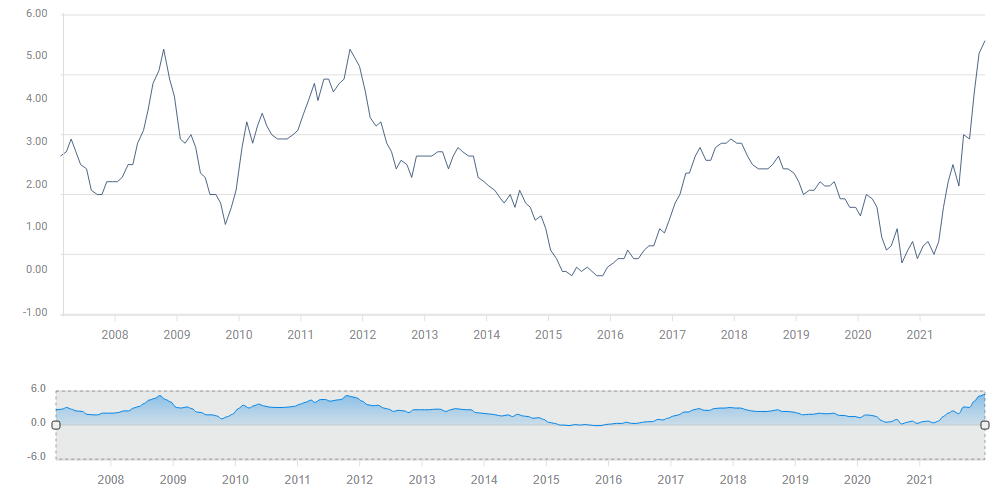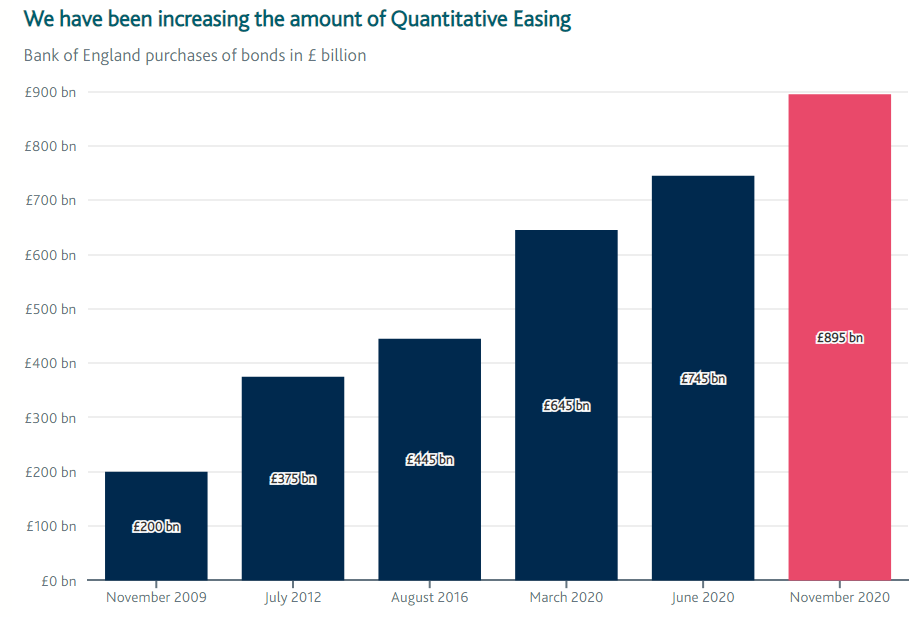- The Bank of England is set to raise rates from 0.25% to 0.50% n the first meeting of 2022.
- Higher inflation and Fed hawkishness back a move.
- Markets fully price in a move, necessitating more action to boost sterling.
- Signaling additional hikes, publishing robust forecasts and squeezing the balance sheet will be eyed.
Will Andrew Bailey bail out the pound? The Governor of the Bank of England's words are set to be more important than his actions in the wake of the Federal Reserve's hawkish tilt. Markets will look beyond a near-certain second rate hike and compare the BOE's hawkishness with the tone from overseas.
BOE Background
The BOE refrained from raising rates in November 2021, surprising markets, and then provided another shocker when announcing higher borrowing costs in December. Apart from seemingly sending confusing messages, investors were perplexed to see the BOE refrain from action when Governor Bailey had a press conference, and moving without an accompanying presser.
The upcoming February meeting is another "Super Thursday," an event that includes not only a rate decision and the accompanying meeting minutes but also the bank's quarterly Monetary Policy Report, which includes updated economic forecasts. It is followed by a press conference by Bailey, which is more important than the rate hike.
The governor earned the unflattering nickname "unreliable boyfriend" due to the surprises listed above, and now there is little room for a surprise on interest rates. Since the BOE hiked borrowing costs to 0.25% in December, economic data has continued showing improvement.
Gross Domestic Product surprised with 0.9% growth in November, the unemployment rate dropped to 4.1% in November and inflation exceeded estimates with 5.4% in December.
UK inflation has surpassed the post-financial crisis peaks:
Source: FXStreet
There is further cause to expect the MPC to raise lending rates by 25 basis points to 0.50% – central banks prefer acting in tandem and the US Federal Reserve's recent hawkish twist gives Bailey and Co permission to follow suit.
Moreover, the recent drop in sterling's exchange rate means imports – which Britain depends on given its perennial trade deficit – become dearer, pushing inflation higher. By hiking, the BOE counters cost of imported goods, as well as cooling domestic demand.
BOE Scenarios and GBP/USD reactions
As mentioned, a rate hike of 25bp is priced in, and if the BOE settles for only that action, GBP/USD could suffer a "buy the rumor, sell the fact" retreat. Therefore the pound will probably fall in the unlikely case that the BOE sits on its hands.
What would move GBP/USD higher? A pledge to further raise borrowing costs would merely keep GBP/USD in place, however, Bailey would boost the pound if he opens the door to moving faster, at increments of 50 basis points – something the Fed has not ruled out.
Given markets' skepticism of Bailey's roadmap signing on rates, it would be wiser to focus on a potential squeeze to the balance sheet. The BOE's Asset Purchase Facility ballooned to £895 billion in the aftermath of the pandemic, and its latest expansion expired late in 2021.
Source: BOE
If Bailey announces a gradual squeeze of the BOE\s balance sheet, sterling would advance. A natural runoff, refraining from reinvestments of maturing bonds, would have a minor positive impact, while an active sale of British debt would already pull money out of markets, boosting the pound's value.
The governor and his colleagues might refrain from details at this point, but rather follow the Fed's footsteps and provide general guidance. That would also support sterling, albeit in a limited fashion.
Last but not least, the BOE's updated forecasts would be of interest. If they point to significantly stronger inflation, it would imply more aggressive action from the BOE. The higher the projected price rises, the higher the pound could go.
Latest BOE fan chart:
Source: BOE
Final Thoughts
The BOE is set to raise rates by 25bp on February 3, and that would be insufficient to keep sterling higher. A mix of pledges to further hike borrowing costs, squeeze the balance sheet and forecast higher inflation would be needed to boost GBP/USD.
Information on these pages contains forward-looking statements that involve risks and uncertainties. Markets and instruments profiled on this page are for informational purposes only and should not in any way come across as a recommendation to buy or sell in these assets. You should do your own thorough research before making any investment decisions. FXStreet does not in any way guarantee that this information is free from mistakes, errors, or material misstatements. It also does not guarantee that this information is of a timely nature. Investing in Open Markets involves a great deal of risk, including the loss of all or a portion of your investment, as well as emotional distress. All risks, losses and costs associated with investing, including total loss of principal, are your responsibility. The views and opinions expressed in this article are those of the authors and do not necessarily reflect the official policy or position of FXStreet nor its advertisers. The author will not be held responsible for information that is found at the end of links posted on this page.
If not otherwise explicitly mentioned in the body of the article, at the time of writing, the author has no position in any stock mentioned in this article and no business relationship with any company mentioned. The author has not received compensation for writing this article, other than from FXStreet.
FXStreet and the author do not provide personalized recommendations. The author makes no representations as to the accuracy, completeness, or suitability of this information. FXStreet and the author will not be liable for any errors, omissions or any losses, injuries or damages arising from this information and its display or use. Errors and omissions excepted.
The author and FXStreet are not registered investment advisors and nothing in this article is intended to be investment advice.
Recommended Content
Editors’ Picks

EUR/USD remains depressed near 1.1350
The US Dollar now grabs momentum and motivates EUR/USD to return to the 1.1350 zone on Thursday, as investors continue to digest the ECB’s decision to lower its policy rates by 25 basis points, as widely estimated. It is worth noting that most markets will be closed on April 18, Good Friday.

GBP/USD maintains the consolidation around 1.3260
The upside momentum in the British pound remains well and sound on Thursday, underpinning the eighth consecutive daily advance in GBP/USD, which now trades in a consolidative fashion near 1.326. Cable’s strong performance comes despite the marked rebound in the US Dollar.

Gold bounces off daily lows, back near $3,320
The prevailing risk-on mood among traders challenges the metal’s recent gains and prompts a modest knee-jerk in its prices on Thursday. After bottoming out near the $3,280 zone per troy ounce, Gold prices are now reclaiming the $3,320 area in spite of the stronger Greenback.

Crypto market cap fell more than 18% in Q1, wiping out $633.5 billion after Trump’s inauguration top
CoinGecko’s Q1 Crypto Industry Report highlights that the total crypto market capitalization fell by 18.6% in the first quarter, wiping out $633.5 billion after topping on January 18, just a couple of days ahead of US President Donald Trump’s inauguration.

Future-proofing portfolios: A playbook for tariff and recession risks
It does seem like we will be talking tariffs for a while. And if tariffs stay — in some shape or form — even after negotiations, we’ll likely be talking about recession too. Higher input costs, persistent inflation, and tighter monetary policy are already weighing on global growth.

The Best brokers to trade EUR/USD
SPONSORED Discover the top brokers for trading EUR/USD in 2025. Our list features brokers with competitive spreads, fast execution, and powerful platforms. Whether you're a beginner or an expert, find the right partner to navigate the dynamic Forex market.


